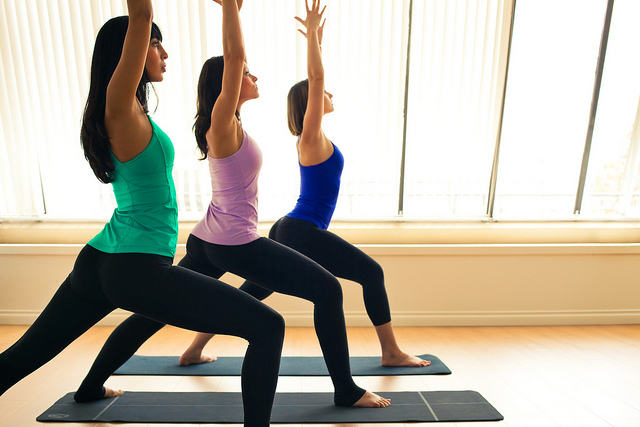
“Don’t let your mind bully your body into believing it must carry the burden of its worries.” ~Astrid Alauda
I don’t believe in the mind/body divide. I can see the gap between them, the one that we put there, but I have little faith in it. In the past month, I’ve learned that in order to live fully, I need to overcome that self-imposed gap.
We all have different mental, emotional, and physical capacities. You could probably run a 5k race, but I’d struggle to even walk it. I know I can work through some of the most difficult decisions, like knowing when to end my pets’ suffering, but you might find that extremely hard to come to terms with.
The thing that we have in common, though, is that we all work at different levels, and whether we choose to believe it or not, our minds and bodies sit together, with each of us.
I took up yoga last month, and I love it. The benefits of getting out for an hour to relax are endless, and I’ve started taking the practice home with me to reap these benefits throughout my week.
I’m headstrong, so I push myself a bit further than I should. Sometimes I go too far and I exhaust myself, or I stretch beyond what my body can manage and end up with extra painful muscles for days.
What’s going on here? It’s that gap between my mind and body.
My mind drags my body places it doesn’t want to go, and I feel sorry for it having to suffer that.
I’ve been practicing a shoulder stand for a few weeks now. At first, it was nearly impossible to get my legs close to my chest without the posture collapsing, or should I say, me collapsing into a heap.
I’d visualize the posture all the time in my head so I should have been able to pull it off, no problem, but I couldn’t. Why?
My body, my back specifically, isn’t strong enough yet to straighten and hold that posture. I can barely sit or stand up straight in my everyday life for long periods of time without getting fatigued. The muscles are underdeveloped, the ligaments and tendons not substantial enough to hold my bones steady.
And all the while, my crazy mind is hurtling ahead saying, “Come on, come on! Let’s go!”
In order for me to achieve the posture, I need to slow my mind down and train my body; both need lessons in giving and receiving information about performing a shoulder stand. This can only be done through cooperative practice.
It doesn’t matter if you’re practicing yoga, perseverance, or patience—you have to practice. You have to go through the motions, learning your limits as you do, and you have to experience it in both your mind and body.
You’re giving a speech, so you should speak those words out loud so you know what they sound like, so you know how to make adjustments. You’re taking a driving test, so you have to attend the lessons and study the rules in order to drive safely and pass that test.
Practice is realizing you can’t control what you will experience by over-thinking, overanalyzing, and forcing your will. You simply have to show up and be there, in both mind and body, allowing for an integrated experience.
When your mind and body aren’t on the same page, you can end up hurting yourself, and you’ll likely set yourself up for frustration, stress, and a persistent sense of disappointment with what is.
Now when I perform a shoulder stand, my mind knows not to run away with itself and leave my body to struggle. My mind communicates with my spine and my muscles, and together they ease their way, inch by inch, into the posture—but only as far as my body can manage.
As my mind has learned to listen and cooperate, my body has learned to speak and become confident, stronger.
With each practice, I can feel the effects of closing the gap between my mind and body. My back feels stronger and it becomes a little straighter every time. My breathing is slow and open. My shoulders feel heavy and support my weight, just like my feet do. My thoughts are focused and clear.
The asana brings my mind and body together. Separate, they’re useless, but together they’re dedicated and powerful.
The gaps between our minds and bodies are evident in all we do. We walk without thinking, and think without an awareness of our physicality. Have you ever bumped into some while out shopping? Was your mind elsewhere when you trod on your cat?
We can all learn to slowly draw ourselves together; become aware of how our thoughts and actions might not always match up. This isn’t a battle. The fight is where our brain and body try to tear away from one another, and try to transcend each other’s company.
Mindful practice of even the most basic tasks like driving, cleaning up, and walking is reconciliation—our opportunity to take hold of our minds and bodies, turn them toward one another, and say “Now, kiss and make up.” There is no war within us, only the blindness to our states and conditions.
Maybe there will always be a slight space between mind and body. A bit of difference is fine. Think of it as space to think and explore, but remember that a space doesn’t have to be a gorge.
To be strong isn’t to have an interminable will or to have a muscular physique; it isn’t about preferring one to the other, mind over matter, prowess over intelligence.
Being strong is sensing your gaps and working with them, drawing them closer, bridging them, and learning from them.
Photo by lululemon athletica
About Sam Russell
Sam Russell is a young writer from the southeastern corner of the UK. He’s a cynic by nature trying to prove that cynics can be happy and positive, too. Visit his blog at http://cackhanded.wordpress.com/.













 Though I run this site, it is not mine. It's ours. It's not about me. It's about us. Your stories and your wisdom are just as meaningful as mine.
Though I run this site, it is not mine. It's ours. It's not about me. It's about us. Your stories and your wisdom are just as meaningful as mine. 